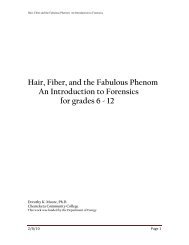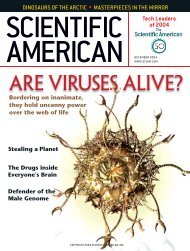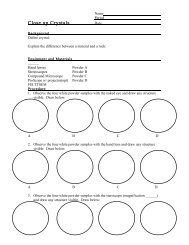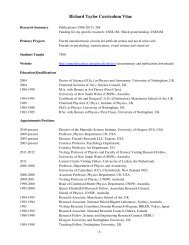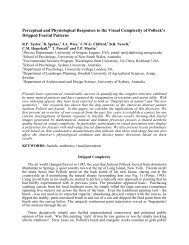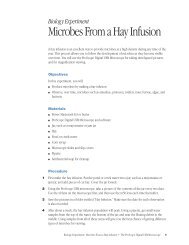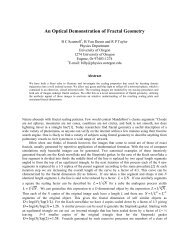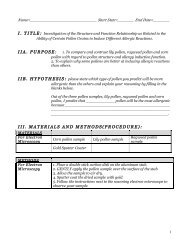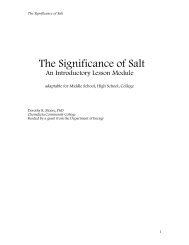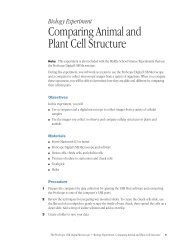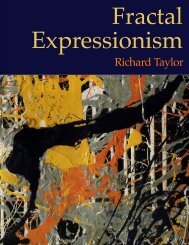Richard Philip Taylor - Materials Science Institute - University of ...
Richard Philip Taylor - Materials Science Institute - University of ...
Richard Philip Taylor - Materials Science Institute - University of ...
You also want an ePaper? Increase the reach of your titles
YUMPU automatically turns print PDFs into web optimized ePapers that Google loves.
2. CAREER EXPERIENCE AND ACHIEVEMENTS<br />
2.1 Research Management: Funding, Technology development, Patents<br />
• <strong>Institute</strong> Directorships: I am currently Director <strong>of</strong> the <strong>Materials</strong> <strong>Science</strong> <strong>Institute</strong> (MSI) at the <strong>University</strong><br />
<strong>of</strong> Oregon, in charge <strong>of</strong> 35 academic faculty, 10 administrative staff and 110 graduate students. The<br />
MSI has an annual grant income <strong>of</strong> $16M. In addition to its research activities, the <strong>Institute</strong> runs highly<br />
active educational and public outreach programs and an industrial internship program. I was previously<br />
invited by the Board <strong>of</strong> Trusties to apply for the Directorship <strong>of</strong> the MacDiarmid <strong>Institute</strong> for Advanced<br />
<strong>Materials</strong> and Nanotechnology in New Zealand (consisting <strong>of</strong> 41 faculty members from 4 universities)<br />
in 2008. I declined this invitation due to my move back to the USA in 2008.<br />
• I am director <strong>of</strong> Fractals Research LLC, a research and development company that generates pattern<br />
analysis s<strong>of</strong>tware and electronic retinal implants. The company also publishes educational books and<br />
technical documents about fractals. Planned future functions include funding PhD fellowships and<br />
educational lecture tours.<br />
• I am head <strong>of</strong> the Fractals Research Laboratory at UO. Comprised <strong>of</strong> typically 10 research students from<br />
the physics, computer science, psychology and human physiology departments, my laboratory provides<br />
a unique research resource. I am a member <strong>of</strong> two major nanoscience research initiatives funded by the<br />
Oregon Nanoscience and Microtechnologies initative (ONAMI): the SNNI (Safer Nano-materials and<br />
Nano-manufacturing Initiative) and the N3 initiative (Nano-metrology, Nano-electronics and<br />
Nanobiotechnology). My research is also part <strong>of</strong> Oregon SuNRISE, a network <strong>of</strong> solar energy<br />
researchers, and BEST, the Oregon Built Environment and Sustainable Technologies Center. In<br />
addition to nano-device physics research, my laboratory has a rapidly growing reputation in biophysics<br />
research <strong>of</strong> human vision.<br />
• During my 26-year research career, I have repeatedly demonstrated my leadership skills in directing all<br />
stages <strong>of</strong> research programs. This includes assembling research teams, establishing laboratories, writing<br />
successful grants, attracting world-class collaborators and communicating results in high pr<strong>of</strong>ile<br />
journals and at international conferences. I have developed and headed successful research projects<br />
based in Australia, New Zealand, Canada, the UK and the USA. One <strong>of</strong> my leadership strengths is my<br />
ability to create research networks that pool the resources and expertise <strong>of</strong> my laboratories with those <strong>of</strong><br />
international leaders in their research fields. Adopting this strategy, I have led 20 highly prolific<br />
international collaborations involving researchers from 10 countries.<br />
• My career has been shaped by international invitations to lead high-pr<strong>of</strong>ile programs, where my<br />
expertise introduced new capabilities to each country’s national research priorities. In 1990, I was hired<br />
by NRC to establish a nano-device program in Canada. I coordinated the activities <strong>of</strong> 15 researchers at<br />
NRC, defining an international force in nano-device physics (as reflected by prestigious publications<br />
and a series <strong>of</strong> successful international workshops at NRC). In 1993, I was invited to establish nanodevice<br />
technologies in Australia and, within a year, I performed the first Australian nano-device<br />
experiment. I helped to design the $1.2M clean rooms <strong>of</strong> the Semiconductor Fabrication Facility (now<br />
the ARC Centre for Quantum Computing) and my devices featured in the 1994 <strong>Science</strong>, Technology<br />
and Engineering Committee report to the Australian government. Since then I have led the UNSW<br />
Mesoscopic Physics Research Group (1995-2000) and the UO Fractals Research Laboratory (2000-11)<br />
(see above).<br />
• I have a record <strong>of</strong> successful research funding throughout my career in the disciplines <strong>of</strong> Physics,<br />
Engineering, Psychology and Art, including financial support from funding agencies in 8 countries.<br />
These include the National <strong>Science</strong> Foundation (USA), the US Air Force (USA), the Office <strong>of</strong> Naval<br />
Research (USA), the Research Corporation for <strong>Science</strong> Advancement (USA), the Murdock Trust<br />
(USA), the Pollock-Krasner Foundation (USA), the Addario Foundation (USA), the National Research<br />
Council (Canada), the British Royal Society (UK), the <strong>Science</strong> and Engineering Research Council<br />
(UK), the Engineering and Physical <strong>Science</strong>s Research Council (UK), the Japanese <strong>Science</strong> and<br />
-3-




